Trees with orange flowers enhance landscapes all around the world with a flash of brilliant color and unmatched beauty. These trees capture with their brilliant hues, from the delicate star-shaped blossoms of the Bonellia macrocarpa to the spectacular crimson blooms of the Eucalyptus phoenicea.
Discover the wide variety of orange-blossomed trees that adorn gardens and natural environments, each with their own distinct beauty.
Different Types of Trees with Orange Flowers
Vera wood (Bulnesia arborea)
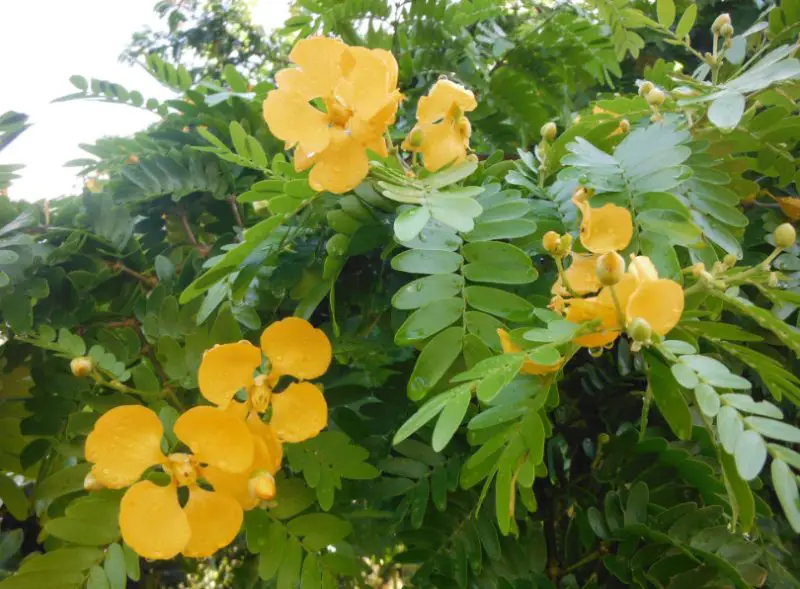
Growing to a height of forty feet with wide crowns, Vera Wood (Bulnesia arborea) is an evergreen tree that lives up to its endearing name. Distinguished by its compound leaves, which can have up to 24 leaflets apiece, it adorns landscapes with magnificent yellow-orange blossoms that have five different petals each.
Orange Champaca Tree (Michelia champaca)
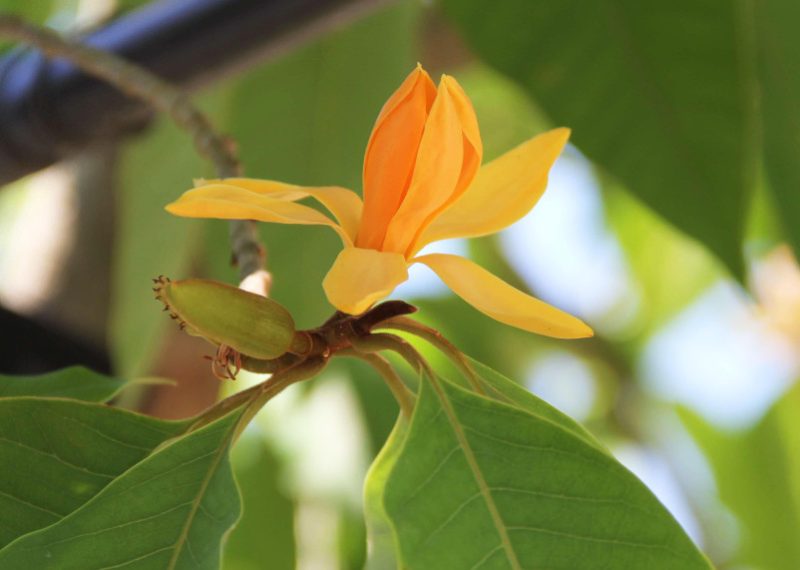
The Orange Champaca Tree is native to Indonesia and India, yet it has spread throughout the world thanks to its enticing creamy-orange flowers. Every bloom has lengthy petals that add to its attraction and an enticing scent. Any environment that this tree graces is enhanced by its lovely aroma and touch of exotic charm.
Flame of the Forest (Butea frondosa)
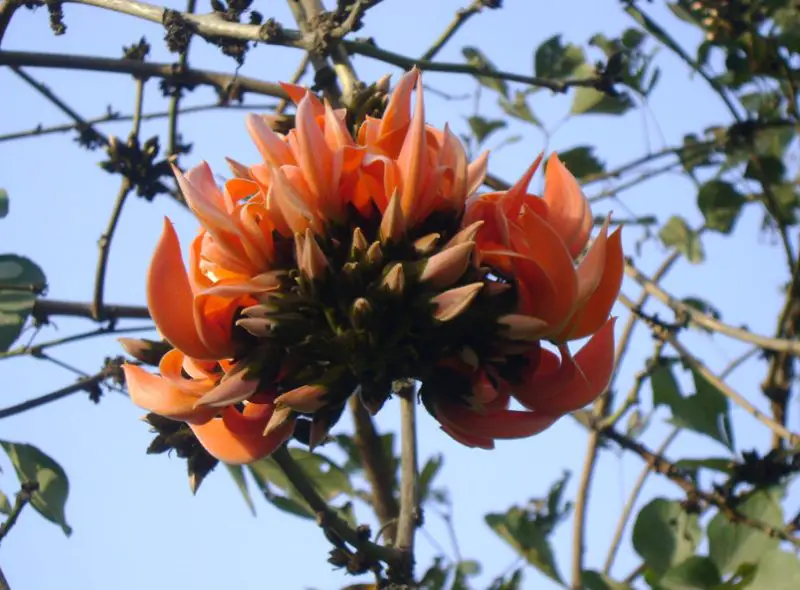
For orange blossoms in home gardens, Flame of the Forest (Butea frondosa) is a standout option. The distinguishing aspect of this plant is its big, pea-like flowers. A compelling addition to any environment, the tree’s winding trunk adds a touch of enchantment to its already enchanting beauty as it grows older.
Scarlet Wisteria (Sesbania punicea)
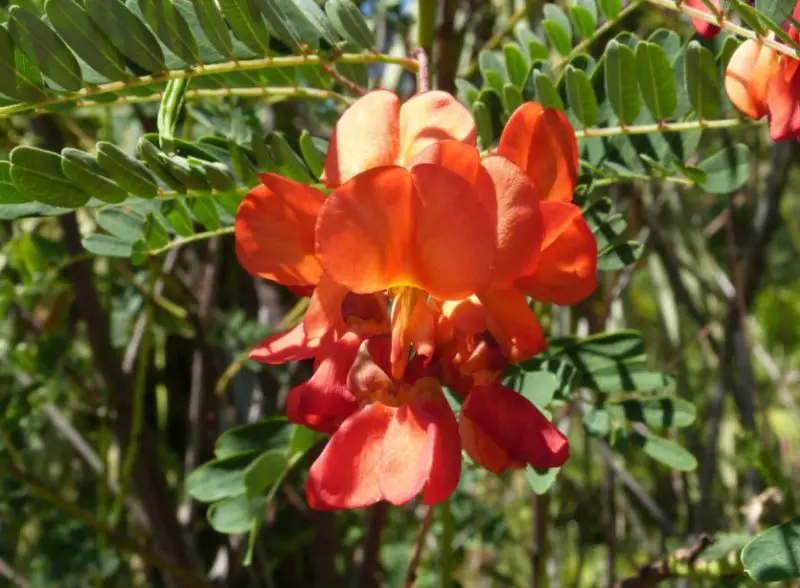
Rattlebox, also known as scarlet wisperia, is a small, invasive deciduous tree belonging to the legume family that can reach a height of eight feet. With several elliptical leaflets, its complex leaves can reach a length of up to 7 inches. This tree’s vivid orange blossoms give a pop of color to any scene, and its name comes from its pods that rattle in the wind.
Fragrant Orange Tea Olive (Osmanthus fragrans f. aurantiacus)
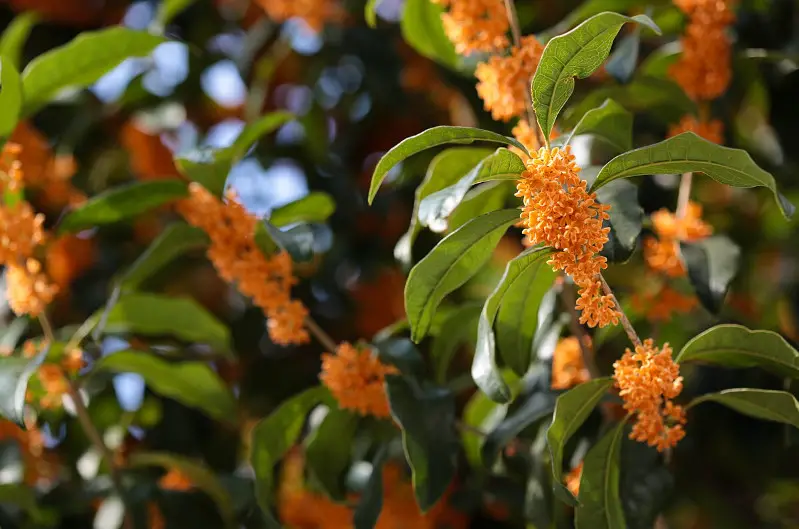
One of the distinguishing characteristics of the Fragrant Orange Tea Olive (Osmanthus fragrans f. aurantiacus) is its delightful perfume. Reaching up to 25 feet in height, this evergreen has thick, eye-catching foliage. It is a pleasant addition to any garden, and its towering beauty becomes an even more compelling spectacle when it explodes into bloom.
Elder Tree (Tecoma Stans ‘Orange Jubilee’)
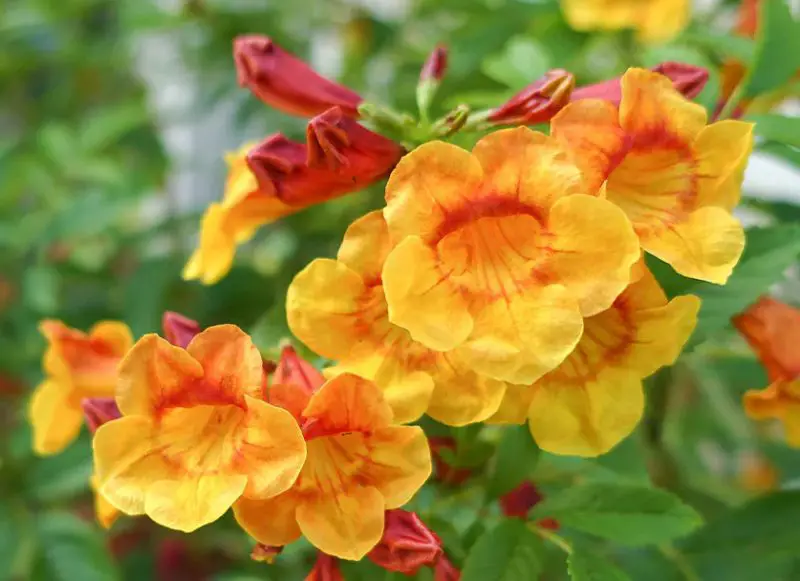
The Elder Tree (Tecoma Stans) cultivar known as “Orange Jubilee” is prized for its brilliant orange trumpet-shaped flowers that bloom for a long time and draw hummingbirds and pollinators. It is perfect for bigger landscapes or as a privacy screen, hedge, or foundation planting because of its glossy, dark green leaves and spreading nature, which allow it to thrive in hot, dry regions. It loves the sun and can withstand droughts, therefore it thrives in direct sunshine.
Orange Bells (Tecoma alata)
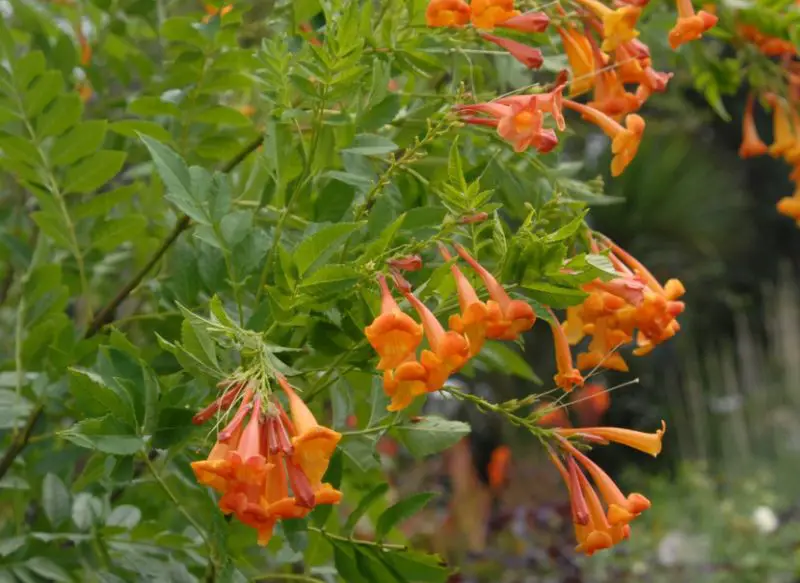
The adaptable orange-flowering shrub known as Orange Bells (Tecoma alata) can be coaxed to grow into a small tree. It is prized for its vivid orange tubular flowers, which bloom from late spring to summer and draw butterflies and hummingbirds with their sweet scent.
Its glossy, luxuriant leaves makes it a great choice for a display plant, hedge, or mixed border. It can grow in a variety of soil types and environments, including semi-arid climates and coastal semi-tropics.
Mexican Bird of Paradise (Caesalpinia pulcherrima)
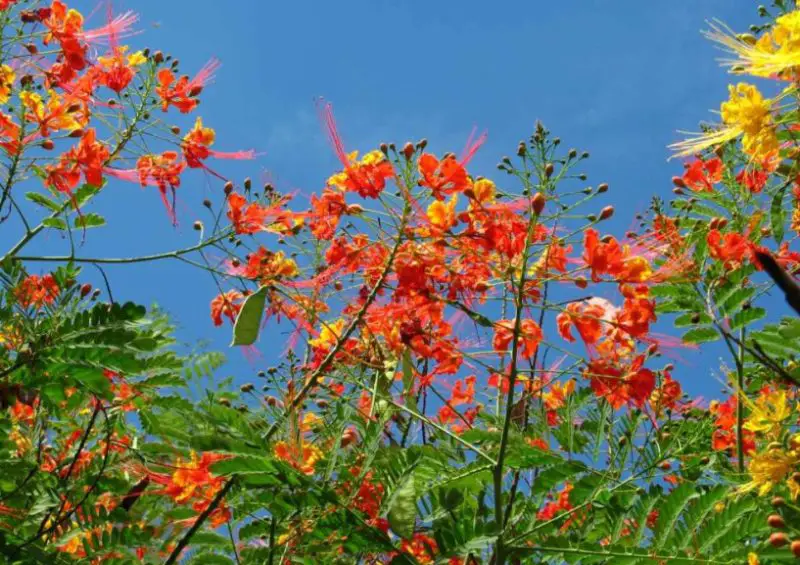
The vibrant orange blossoms of the Mexican Bird of Paradise (Caesalpinia pulcherrima) tree adorn landscapes all year long. With their clusters of vivid orange flowers and their curly stamens, it makes beautiful arrangements against the ferny leaves. It’s low maintenance and drought-tolerant, making it a great option for tropical landscapes, xeriscapes, and desert gardens. It also thrives in hot regions.
Flame Azalea (Rhododendron calendulaceum)
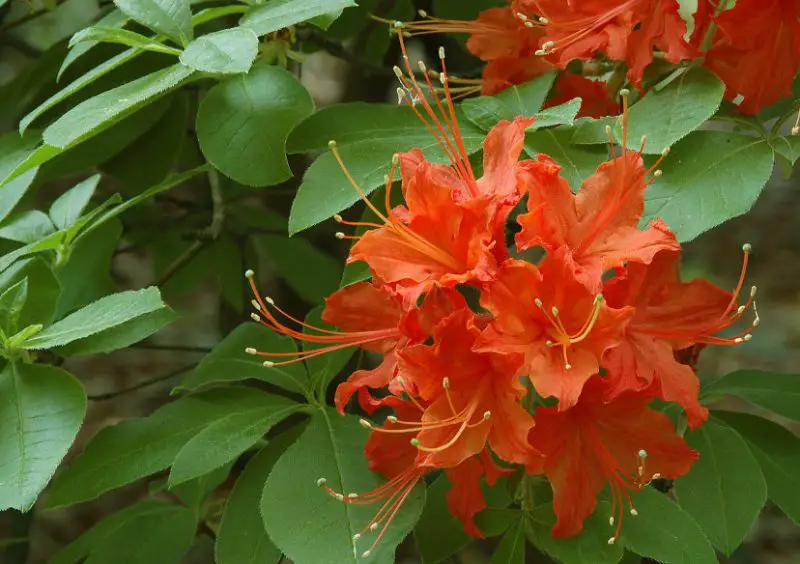
Rhododendron calendulaceum, sometimes known as the Flame Azalea, is a fascinating deciduous shrub that can be trained to grow into a tree and boasts flaming orange flowers that resemble candle flames. During a two-week period in late spring and summer, the rounded canopy of the plant blooms magnificently with orange-red blossoms.
Fuzzy-textured green foliage that turns yellow-orange in the fall makes it a great choice for privacy screens, mixed borders, and foundation planting. Thriving in acidic, well-drained soil, it prefers partial shade to full sun for optimal growth.
Orange Hibiscus Tree (Hibiscus rosa-Sinensis)
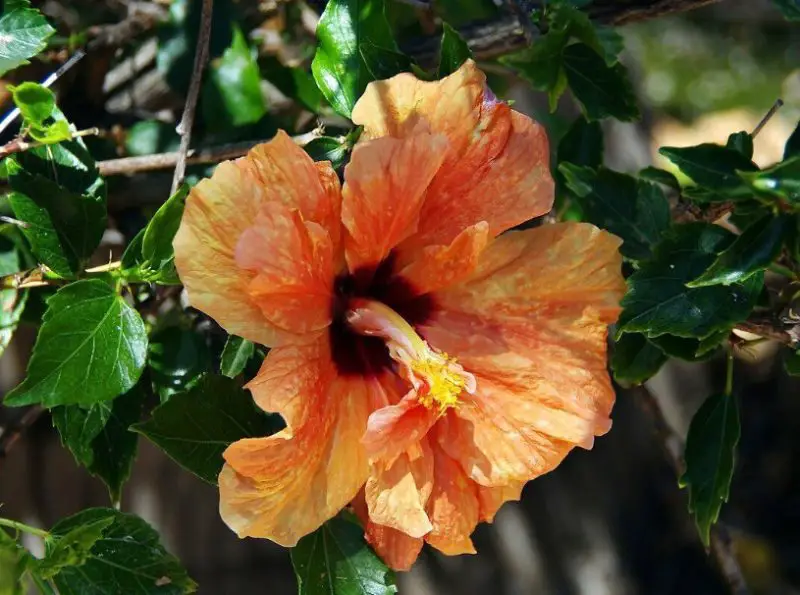
One of ornamental trees with the most vivid orange blossoms is the Orange Hibiscus Tree (Hibiscus rosa-Sinensis). They add splashes of color to landscapes all year round with their wide, papery petals and conspicuous center stigma. They make striking group plantings or focal pieces and are popular in tropical landscapes. Apricot Brandy, Cheri, Electric Orange, and High Definition are a few examples; each has distinct orange colors and growth traits.
Red Silk Cotton Tree (Bombax ceiba)
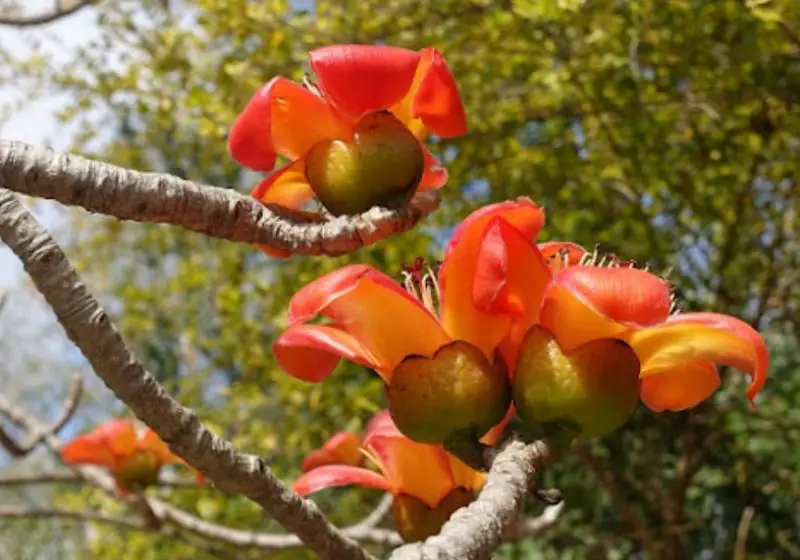
Although native to Northern Australia, the Red Silk Cotton Tree (Bombax ceiba) has spread its roots throughout the United States and other countries. It is distinguished by its wide canopies, clusters of vivid orange blooms, and spiky trunks and lobed leaves. This magnificent tree gives landscapes all across the world a burst of color and personality.
Elder Tree (Tecoma stans)
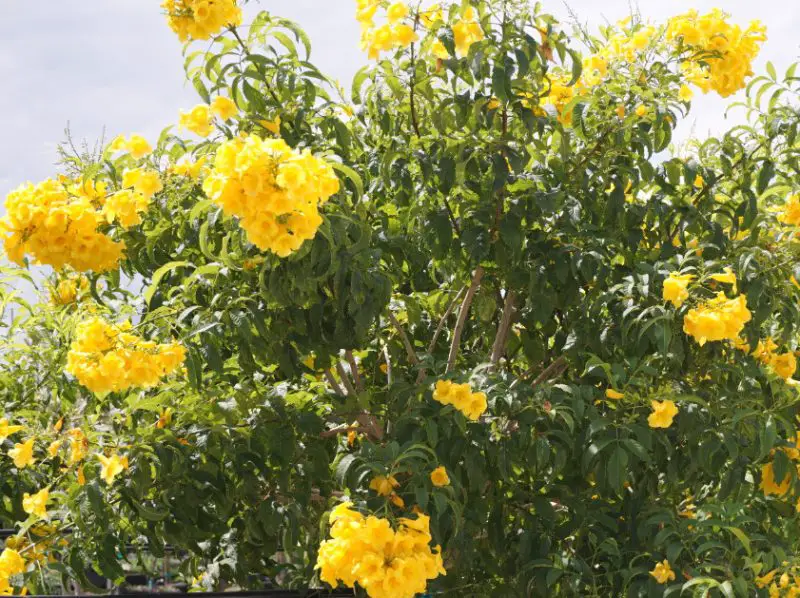
At up to 25 feet tall, the Elder Tree (Tecoma stans) is a small miracle. Its striking beauty is belied by its modest size, especially when it blooms. The tree adorns itself with clusters of orange blossoms that resemble trumpets, enticing everyone who views its exquisite yet eye-catching show.
African Tulip Tree (Spathodea campanulata)
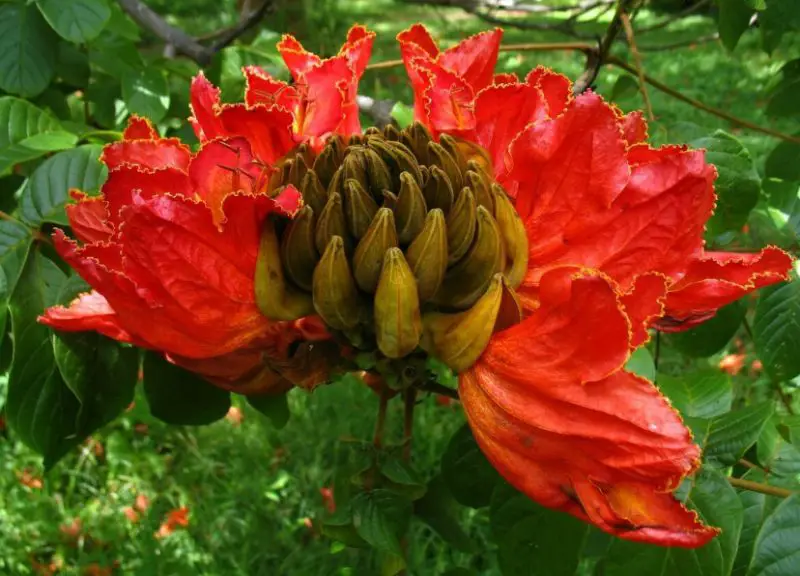
Originating in Africa, the African Tulip Tree (Spathodea campanulata) is mainly found in the continent’s northern and equatorial regions. It is frequently grown as a specimen plant and can grow up to 80 feet tall with wide crowns. It’s breathtaking, with bright orange blossoms the size of softballs. But be careful—its old branches may be hollow, so it’s best not to climb.
Scarlet Sterculia (Sterculia colorata)
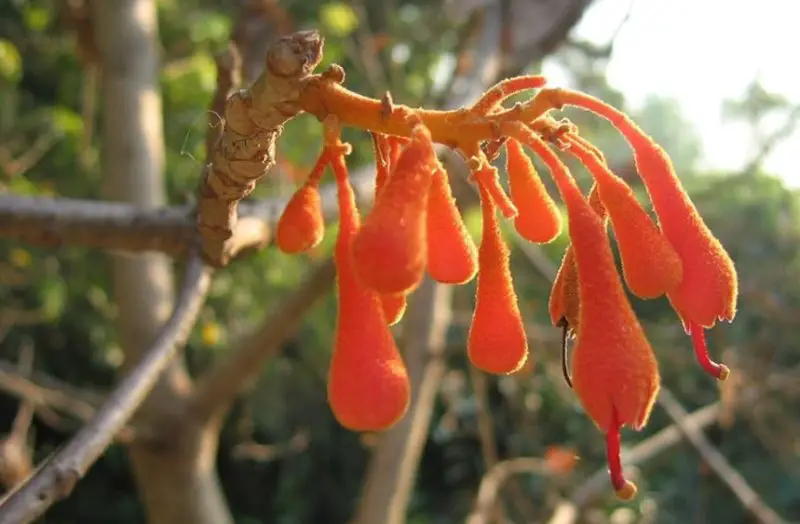
The Scarlet Sterculia (Sterculia colorata) is a tropical tree admired for its vibrant orange-reddish flowers, arranged in large clusters. Despite their stunning appearance, the flowers emit a foul odor. Blooming in early spring, they create a spectacular sight, attracting attention in any landscape.
With a wide-spreading canopy, they provide ample shade, making them ideal for urban gardens or informal screens. Thriving in full sun to partial shade within USDA zones 6 to 9, they reach 30 to 50 feet tall and 20 to 30 feet wide.
Scarlet Gum Tree (Eucalyptus phoenicea)
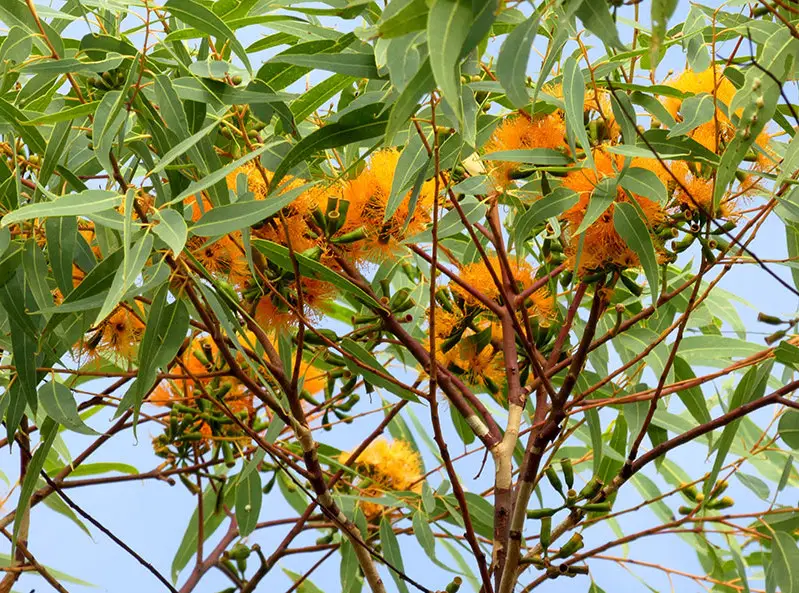
Eucalyptus phoenicea, often known as the Scarlet Gum Tree, is widely recognized for its vivid orange blossoms that cluster in umbrella-like formations and are ornamented with orange stamens with yellow tips. This native Australian plant has beautiful peeling bark and lance-shaped gray-green leaves.
It grows well in hot, dry areas. It grows quickly and provides privacy, windbreak, and shade, giving gardens year-round aesthetic appeal. It is ideal for full sun exposure in USDA zones 8 through 10, growing to a height of 13 to 40 feet with a canopy that spreads widely.
Cudjoe Wood Tree (Bonellia macrocarpa)
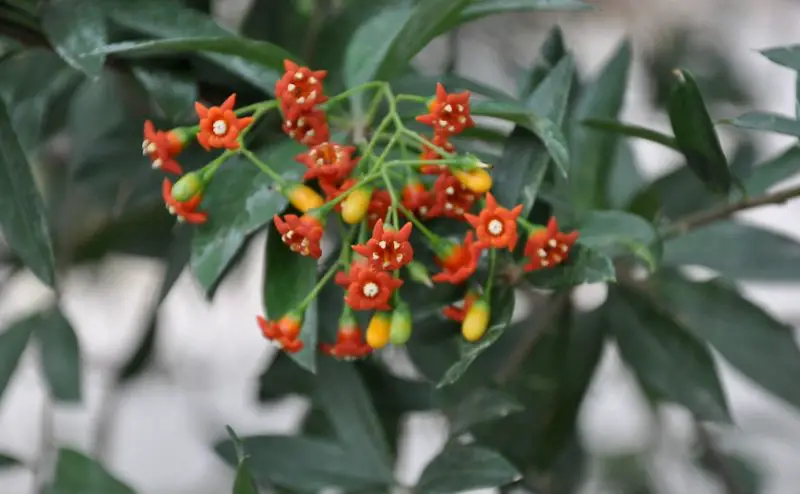
The orange blossoms of the Cudjoe Wood Tree (Bonellia macrocarpa) resemble stars, making it stand out. It grows well in Florida because it is sun-loving and heat-tolerant, and because of its dense, evergreen foliage and lance-shaped leaves.
It is suitable for coastal gardens and can withstand drought and sea. It blooms in the spring and early summer to draw pollinators. It grows to be 6 to 15 feet tall and likes full sun and well-drained soil in USDA zones 10 and 11.
Orange Frangipani Tree (Apricot Plumeria)
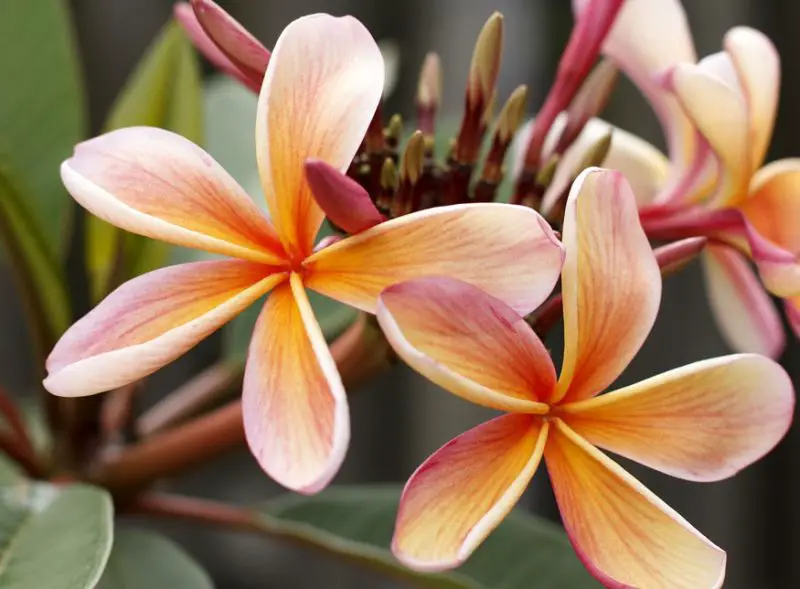
The Orange Frangipani Tree (Apricot Plumeria) is renowned for its vibrant, fragrant apricot-orange and pink blooms. With star-shaped petals, these flowers contrast beautifully against glossy dark green leaves. Popular in tropical gardens, it adds color as a shade tree or specimen. Suitable for containers in colder climates, it thrives in full sun within USDA zones 10 to 12, reaching up to 26 feet tall and 13 feet wide.
The Geigertree (Cordia parvifolia)
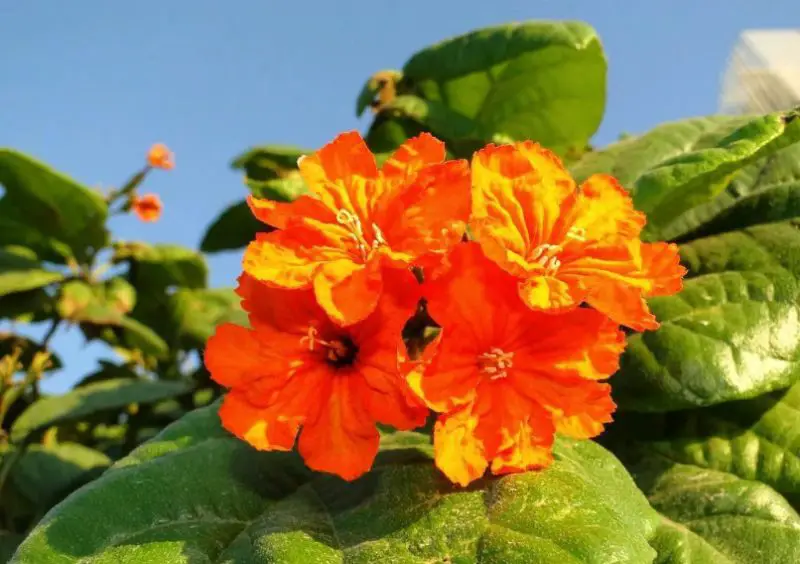
Large, oblate, dark green leaves and unusual orange, frilly blooms gracing the tops of its branches are the distinguishing features of the Geigertree (Cordia parvifolia). It may reach a height of 25 feet and is well known for its ability to withstand extreme weather, including drought and flooding, which makes it a durable option for landscapes.
Royal Poinciana (Delonix regia)
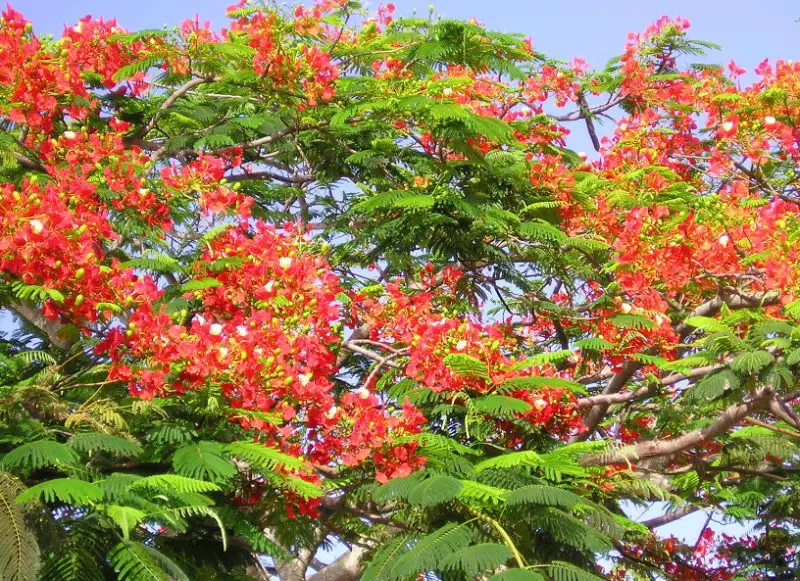
Delonix regia, often known as the Royal Poinciana, is notable for its magnificent orange blossoms and for being a superb shade tree. With its expansive, 60-foot-wide crowns and 50-foot height, this tree adorns landscapes with its deep orange blooms. It is a versatile option for any garden due to its remarkable drought and pest resistance, as well as its ability to thrive in a variety of soil conditions.
Jamaican Rain Tree (Brya ebenus)
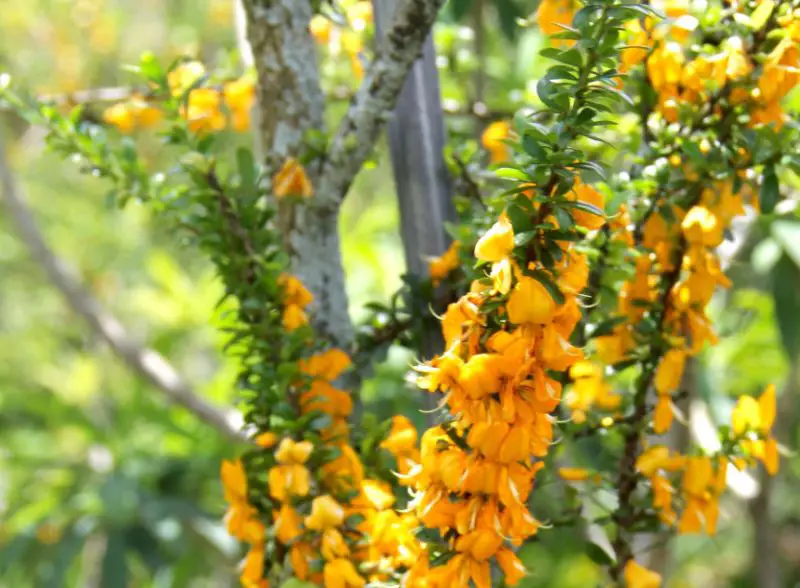
The large oval-shaped leaves of Jamaican rain trees, which are native to the West Indies, can grow up to three inches in length. When in full bloom, their crowns become a sight to behold, with pea-flower flowers dangling in clusters that range in color from creamy orange to yellow-orange, illuminating the surrounding area in brilliant hues.
Pomegranate (Punica granatum L.)
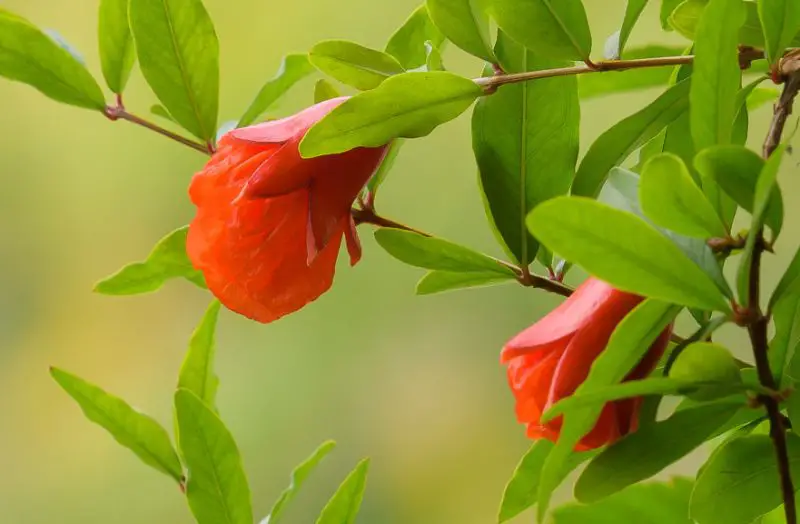
Grown for their tasty and nourishing fruit, pomegranates (Punica granatum L.) are also prized for their beautiful orange flowers that resemble trumpets. Large clusters of these blooms, with their frilly petals adding to their attractiveness, hang delicately from the tree’s limbs, adorning it.
Southern Silky Oak Tree (Grevillea robusta)
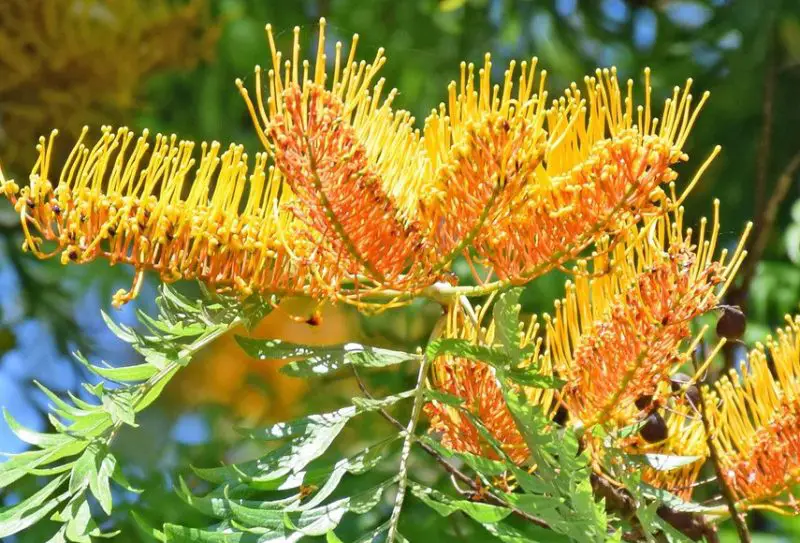
Grevillea robusta, also known as the Southern Silky Oak Tree, is a stately evergreen that produces eye-catching yellowish-red or yellowish-orange blooms with noticeable yellow-tipped stamens. Its quick growth pattern contrasts with the dark green foliage to produce vibrant clusters.
Its towering, upright growth provides shade and wildlife habitat, making it perfect for expansive landscapes. It can withstand drought and grows well in sandy soil that receives full sun and well-drained conditions in Southern states like Florida, Texas, and California.
Angel’s Trumpet (Brugmansia)
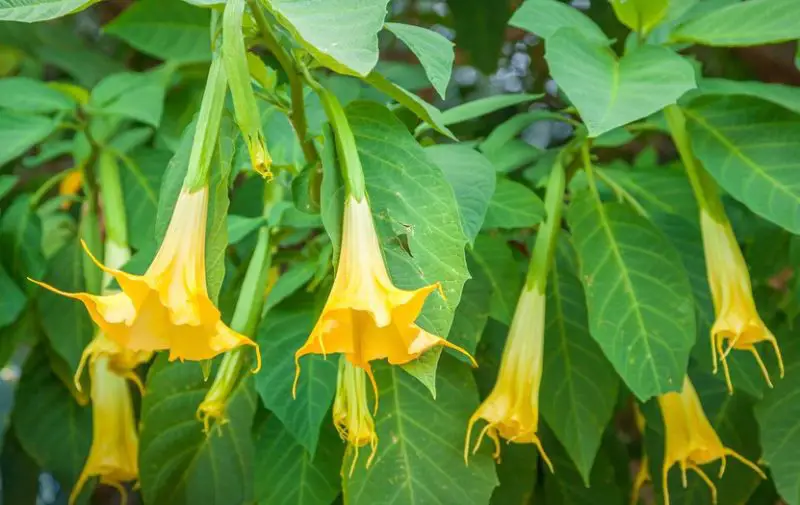
The semi-tropical tree known as Angel’s Trumpet (Brugmansia) is prized for its love of sunlight and trumpet-shaped, pale orange to yellow flowers. These fragrant blossoms provide a magnificent display hanging softly from arching branches, drawing pollinating insects.
It is a striking focal point in gardens and is perfect for accents, specimens, or container growth because to its huge funnel-shaped blossoms, which may reach a length of 12 inches, and its dense, umbrella-like canopy. But because of its extreme toxicity, it needs to be handled carefully and needs frequent pruning and feeding.
Geiger Tree (Cordia sebestena)
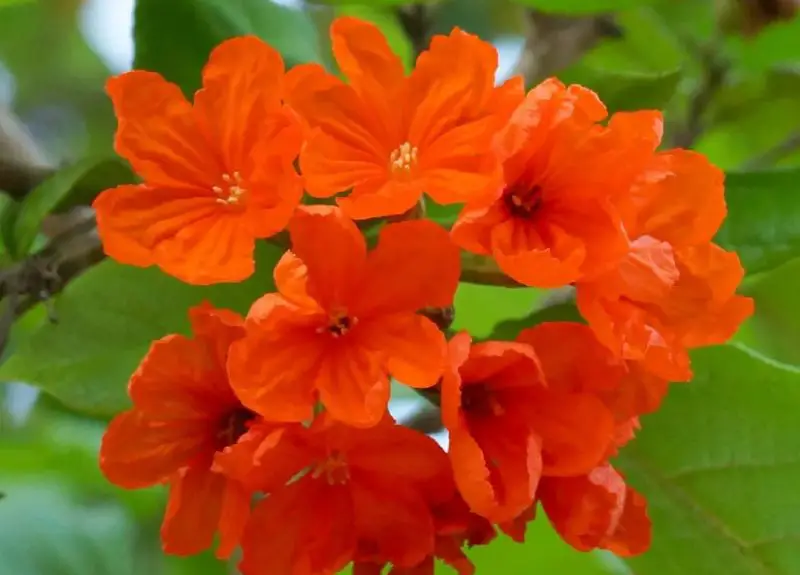
The heart-shaped leaves and vivid orange blossoms of the Geiger Tree (Cordia sebestena) set it apart. Its trumpet-shaped flowers, which cover the circular canopy in rich orange hues during the summer and fall, have the ability to bloom year-round in mild winters.
It is a native of Florida and is often seen in tropical environments. Because of its modest size, resistance to salt, and ease of maintenance, it is perfect for small gardens or coastal areas. It does well in a variety of soil types and grows well in both full and partial sunlight.
Ozark Witch Hazel (Hamamelis vernalis)
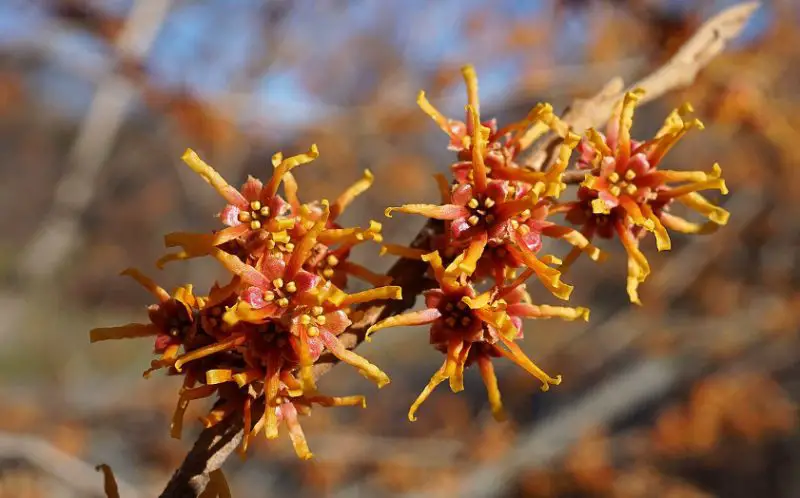
A pretty deciduous tree, Hamamelis vernalis, or Ozark Witch Hazel, blooms fragrantly in late winter and early spring in clusters of dull orange or reddish-orange flowers. Well-known for its spiky blossoms, it provides a splash of color just before leaves appear. It is a landscape plant that can be used as a hedge, specimen plant, or flowering screen. It grows well in USDA zones 4 through 8, and it can withstand full sun to light shade.
Flowering Maple ‘Victor Reiter’ (Abutilon ‘Victor Reiter’)
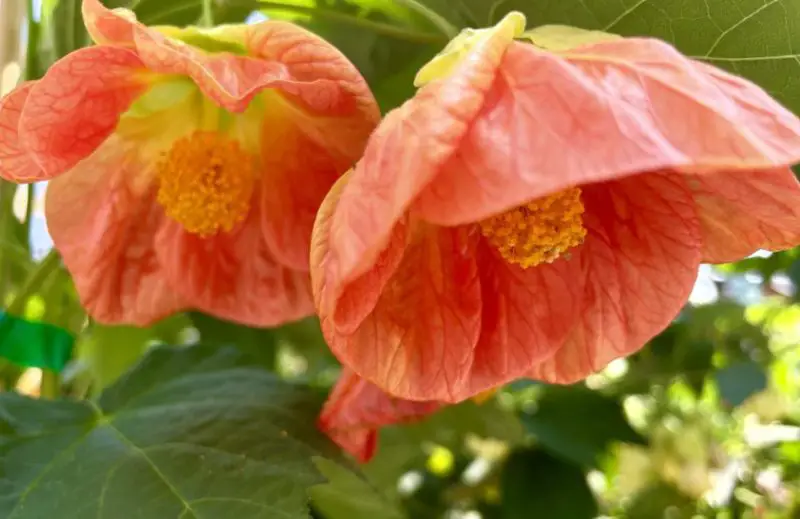
Abutilon ‘Victor Reiter,’ often known as the Flowering Maple, is a tiny tree that is well-known for its gorgeous orange blossoms that resemble bells. With their greenish-yellow throats, these outward-facing flowers swing gently on branches resembling vibrant bells, providing abundant blooming from spring to fall.
It thrives in sunlit settings with well-drained, wet soil and gives a brilliant splash of color to gardens or pots with its dark green maple-like foliage.
Japanese Flowering Quince (Chaenomeles Japonica)
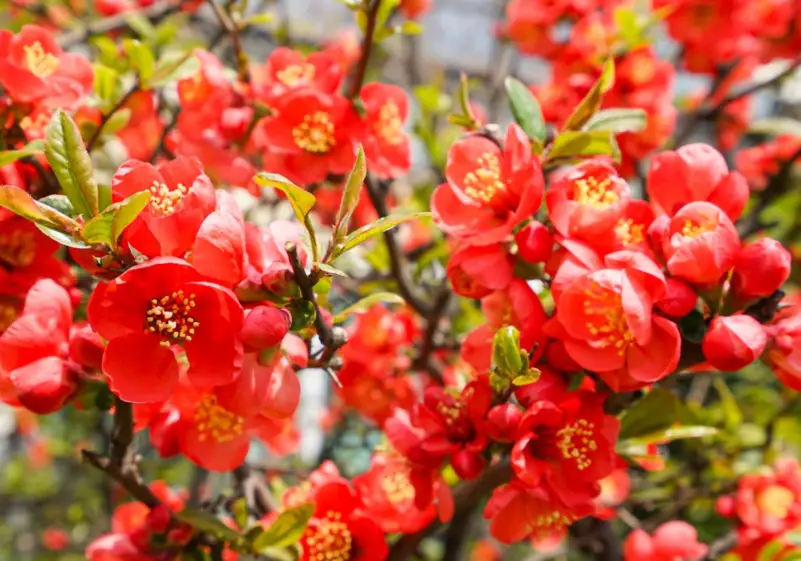
The Japanese Flowering Quince (Chaenomeles japonica) is a charming deciduous shrub, prized for its vibrant orange-scarlet flowers. Blooming in clusters before the leaves emerge, it adds a burst of color to early spring landscapes.
Versatile in gardens, it serves as a low hedge, shrub border, or container plant, with spiny branches ideal for security screens or foundation plantings. It thrives in USDA zones 5 to 9, reaching 2 to 3 feet tall and 3 to 6 feet wide.
Chilean Orange Ball Tree (Buddleja globosa)
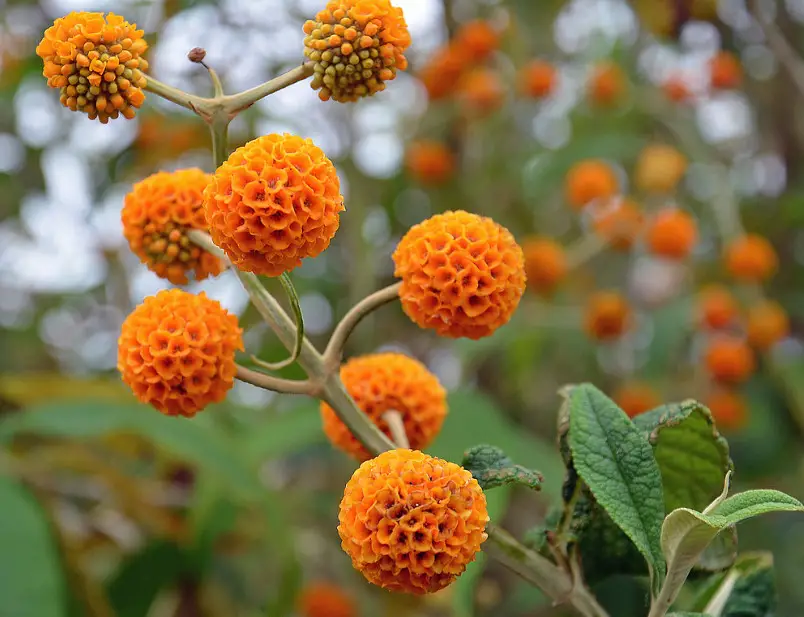
The Chilean Orange Ball Tree (Buddleja globosa) is a stunning bush adorned with bright orange tubular flowers in globular clusters. Blooming throughout summer, it attracts butterflies and bees, adding vibrant color to sunny gardens.
With lance-shaped gray-green leaves and a compact growth habit, it’s perfect for small spaces and easy to prune. Drought-tolerant and deer-resistant, it thrives in USDA zones 7 to 10 with full sun exposure.
Orange Bottlebrush Tree (Callistemon ‘Tangerine Dream’)

The Orange Bottlebrush Tree (Callistemon ‘Tangerine Dream’) is a versatile orange-flowering shrub, adaptable to small ornamental tree training. Sporting vibrant, bottle brush-like orange flowers, it blooms in spring and sporadically year-round, attracting hummingbirds and butterflies. Popular for garden color, it serves as an informal hedge, screening plant, or container feature, thriving in full sun within USDA zones 10 to 12.
Coast Coral Tree (Erythrina caffra)
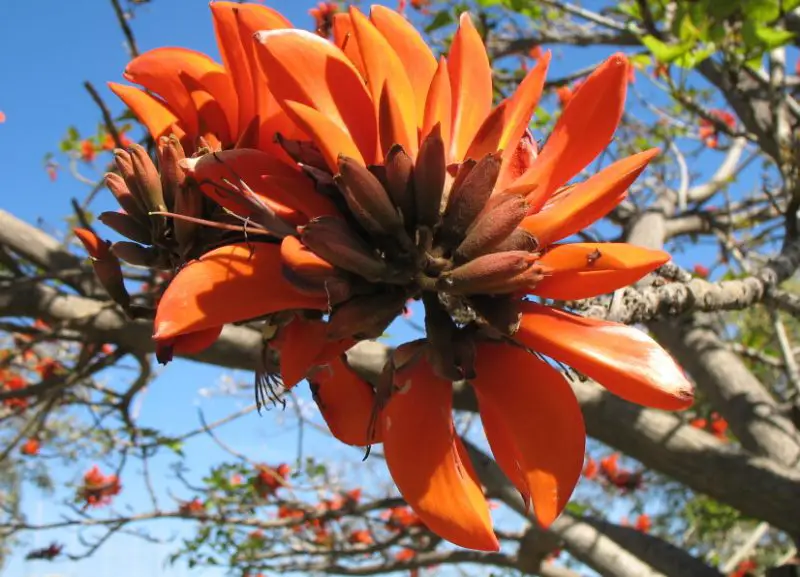
The gorgeous medium-to-large Coast Coral Tree (Erythrina caffra) is covered with eye-catching orange blossoms that bear a remarkable resemblance to deep coral. They attract butterflies and birds and bloom from late winter to late April.
It gives landscapes a charming decorative touch with its smooth trunk and glossy dark green leaves. Growing best in USDA zones 9 through 11, this plant prefers full light, but its prickly trunk makes it inappropriate for planting next to playgrounds or paths.
Australian Christmas Tree (Nuytsia floribunda)
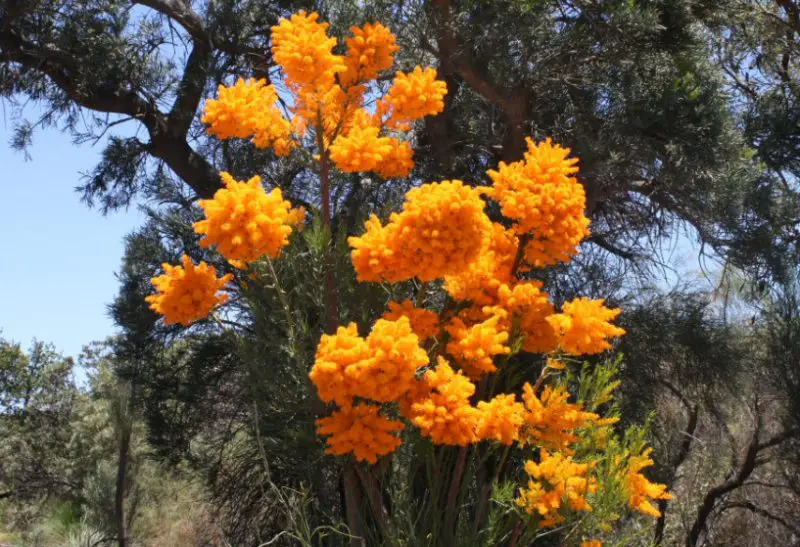
The Australian Christmas Tree (Nuytsia floribunda) is renowned in the Southern Hemisphere for its vibrant orange blooms, decorating landscapes in December. Its small tubular flowers cluster on spongy branches, while its hardy nature makes it adaptable to various soils. Popular for its eye-catching blooms and compact growth, it thrives in full sun to partial shade within USDA zones 9 to 11, reaching up to 33 feet tall.
Ashoka Tree (Saraca asoca)
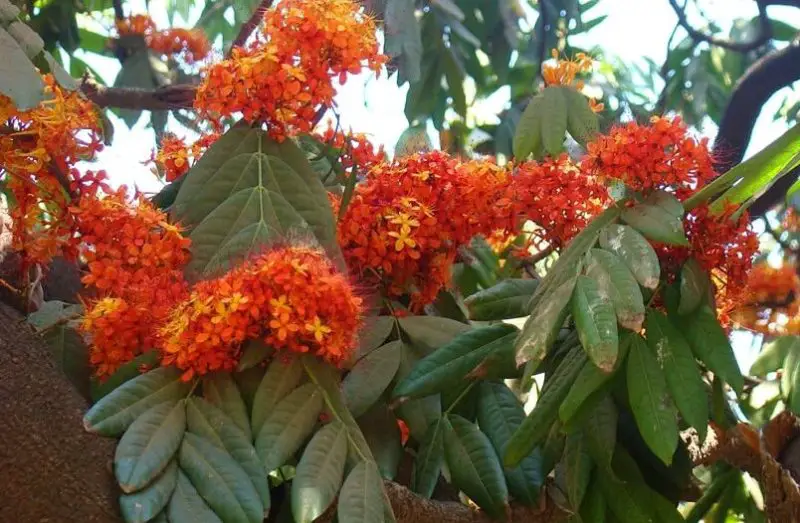
The gorgeous clusters of rich orange blooms and the appealing evergreen foliage of the Ashoka Tree (Saraca asoca) make it a highly valued plant. Its vivid yellow-orange flowers that eventually turn deep crimson provide landscapes a burst of color.
It grows well in a variety of soil types and is low-maintenance, versatile, and perfect for butterfly gardens, garden borders, and ornamental purposes. Growing up to 30 feet tall and wide, it thrives in USDA zones 10 through 12 when exposed to full light.






